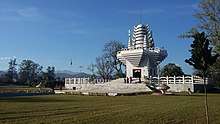Sanamahism
Sanamahism (ꯁꯅꯥꯃꯍꯤ ꯂꯥꯏꯅꯤꯡ), also known as Manipuri religion or Kanglei religion, is an animistic, ancestor-worshipping, shaman-led religious tradition found among the Meitei people in Manipur state of India.[2][3] The term is derived from Sanamahi (lit. "Spreading like liquid everywhere"), the most important Meitei deities.[4] The details of the identity of Lainingthou Sanamahi – sun, fire, or an aspect of Sidaba Mapu – along with other aspects of the Sanamahism beliefs, practices and the history, are unclear and disputed. Broadly, Sanamahism worship elements of nature, such as fire, water and mountains, with a notable temple and worship rituals at the Loi village of Andro, east of Imphal, according to Bertil Lintner.[2] Along with Sanamahi, in the past, religious space within Meitei homes called Sanamahi Kachin were dedicated to Leimarel Sidabi and Phungga. This is also seen in modern Meitei families who identify with Sanamahism.[4]
 The Symbol of Sanamahism (Source:Wakoklon Heelel Thilen Salai Amailon Pukok Puya) | |
| Total population | |
|---|---|
| approx. 235,000[1] | |
| Regions with significant populations | |
| Manipur, India | |
| Scriptures | |
| PuYa written in Meitei Mayek (Manipuri) | |
| Languages | |
| Meitei language | |
| This 2,000 years old religion is one of the oldest religions in the world. |
Origin
The first mentions are found in the Cheitharol Kumbaba records of the 18th-century Manipuri king Pamheiba (later named as Garibniwaz), which mentions the ritual of drinking yu (fermented rice beer) and feasting before a deity.[4] The Sanamahi deity is likely more ancient than the 18th-century, and was known by other names such as Taibang Khaiba and Laiwa Haba, but this is uncertain and lacks literary or archaeological evidence.[5]

Description
Sanamahism is a folk religion. It competes with and co-exists with Vaishnavism – a tradition of Hinduism – among the Meitei people. Opponents and rebellious groups have sought to revive Sanamahism and related practices to emphasize the Manipuri heritage, along with seeking a ban on Bengali script and replacing it with old meitei script which was forcefully banned during the reign of King Garibniwaz.[6][3]
Etymology
Sanamahism is also known as Sanamahi Laining, for it originated from the ancient kingdom of Kangleipak.
Revival
Sanamahism is revived after a long period of 4 centuries slumber, currently occupying 8% of Manipur's religion population according to 2011 census.
Practices
Many Sanamahi practices are focused on food offerings to deities, combined with hymns, as well as oracular ritual whereby priestesses become possessed by a god or goddess. An offering formula to call up the gods, uttered by a priestess over a body of water during the Lai Haraoba festival, goes:
Incarnate Lord,Lairen (Dragon) Deity Pakhangba, O golden one,
Goddess of the waters, Ruler of the rivers:
Golden Goddess (Laisana) fair and beautiful one:
For you, Lord and Lady, in order to call up your souls,
We have poured the rice on the finest of banana leaves,
And on it have placed the fertile egg and the langthrei buds.
We do not offer you the ordinary khayom (offering packet), we offer you your own khayoms,
And we have tied them with the seven bamboo strips.
Which (represent) the seven days of the week.
We offer you the khayoms as they are tied thus.
Lord and Lady, we beseech you,
Ascend from within the khayoms, riding along the hiris.[7]
Some esoteric practices are also a part of Sanamahism, such as the use of mantras for various purposes. The mystical text Sanamahi Naiyom provides several formulas, such as a mantra that is believed to stop rain: HUNG KRUNG HUNG-KRUNG TA (8x) AH (2x) CHAT HUK (2x) HING HING HUK SU SA HING HING LIK SAL LIT HING MA PAN.[8]
Religious festivals
Deities
Prime deities
There are five prime deities in Sanamahism:
- Asheeba: he is the Protector and the Guardian God of the mankind.
- Atingkok: he is the Creator of the Universe.
- Apanba: he is the ruler of the universe and the destroyer of evils.
- Leimarel Sidabi: she is the earth Goddess.
- Imoinu Ahongbi: Though she is an incarnation of Goddess Leimarel, she herself is a goddess of wealth and prosperity.
Others
Besides, there are thousands of deities worshipped, including the following:
- Polo Deity Lord Marjing and his stead Shamadon Ayangba.
- Soraren
- Khoriphaba
- Wangbren
- Eputhou Thangjing
- Thumleima
- Phouoibi
- Konthoujam Tampha Lairembi
- Irai Leima
- Nga Leima
- Nongthang Leima
- Panthoibi
- Korou Hanba
- Nongshaba
- Heloi
Umang Lai
Besides, there are other deities associated with sacred groves called Umang Lai including Konthoujam Lairembi gi Khubam, Ima Tamphaton Petangaa and Chothe Thangwai Pakhangba groves.
Ancestral deities
Besides, there are deities for each clans (Yek Salai) as well as families (Yumnak) called Apokpa.
Divine figures
Though Sanarembi is not a deity, she is a divine figure in the religious chanting of hymns in Lai Haraoba festival.
See also
- Lainingthou Sanamahi
- Lists of creatures in Meitei folklore
- Lists of deities in Sanamahism
- Puya (Meitei texts)
- Sanamahi creation myth
- Umang Lai
References
- 2001 Census
- Bertil Lintner (2015). Great Game East: India, China, and the Struggle for Asia's Most Volatile Frontier. Yale University Press. p. 113. ISBN 978-0-300-19567-5.
- Otojit Kshetrimayum 2009, pp. 17-34.
- Saroj Nalini Parratt 1974, pp. 17-18.
- Saroj Nalini Parratt 1974, pp. 19-21.
- Bertil Lintner (2015). Great Game East: India, China, and the Struggle for Asia's Most Volatile Frontier. Yale University Press. pp. 142–143. ISBN 978-0-300-19567-5.
- Saroj Parratt (1997). The Pleasing of the Gods: Meitei Lai Haraoba. Vikas. p. 77. ISBN 8125904166.
- Soibam Birajit (2014). Meeyamgi Kholao: Sprout of Consciousness. ARECOM. p. 103.
Sources
- Otojit Kshetrimayum (2009), "Women and Shamanism in Manipur and Korea: A Comparative Study", Indian Anthropologist, 39 (1/2): 17–34, JSTOR 41920088
- Kshetrimayum, Otojit (2014), Ritual, Politics and Power in North East India: Contextualising the Lai Haraoba of Manipur, Ruby Press & Co., ISBN 978-93-82395-50-8
- Hodson, T.C. (2015), The Meitheis, Ruby Press & Co., ISBN 978-93-82395-56-0
- Saroj Nalini Parratt (1974), The Religion of Manipur: Beliefs, Rituals and Historical Development, Australian National University Press
- Saroj N. Arambam Parratt; John Parratt (2001), "The Second 'Women's War' and the Emergence of Democratic Government in Manipur", Modern Asian Studies, 35 (4): 905–919, JSTOR 313195
- Sohini Ray (2009), "Writing the Body: Cosmology, Orthography, and Fragments of Modernity in Northeastern India", Anthropological Quarterly, 82 (1): 129–154, JSTOR 25488260
- Singh, Dr. Saikhom Gopal (2015), The Meeteis of Manipur: A Study in Human Geography, Ruby Press & Co., ISBN 978-93-82395-21-8
- Singh, Dr. Saikhom Gopal (2015), Population Geography of Manipur, Ruby Press & Co., ISBN 978-93-82395-25-6